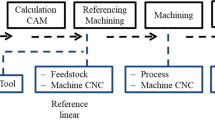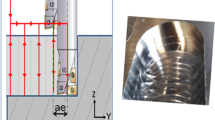Abstract
The quality of the workpiece produced by CNC machine tool is primarily due to the degree of precision and stability of the machines themselves. In general, the quality measures the degree of conformity of a part with predefined dimensions and geometric specifications. However, a simple measure does not identify the contribution of each source of error affecting the room. It is therefore important to analyze the technological aspects of machine tools, numerical control and the influence of the process. In order to give the issues of precision machine tools a conceptual dimension, it is preferable to classify the affecting factors. Errors can be classified according to the working phase during which the sources that generate them are active. During the preparation phase, errors can be associated with setting procedures, errors in the programming, and machining programs converted into machine language. During the machining phase, the sources of error which affect the accuracy are much more varied. Their effects can be considered as the combination of the individual contributions of all the elements constituting the system machine tool cutter, as well as the interaction of this system with the process. The purpose of this article is to present a study on the evaluation of the geometrical errors of a machine tool EMCO PC MILL 155 that exists within our laboratory, which are due to cut efforts.






















Similar content being viewed by others
Abbreviations
- R P :
-
The piece reference
- R 1 :
-
The carriage reference along the X axis
- R 2 :
-
The table reference along the Y axis
- R 3 :
-
The turret reference along the Z axis
- R 4 :
-
The tool reference
- σ xx :
-
Linear straightness deviations according to X (mm)
- σxy, σxz :
-
Horizontal linear deviations along Y and Z (mm)
- εxy, εxz, εxx :
-
Angular yaw deviations, pitch angular deviations, and rolled angular deviations
- σpx, σpy, σpz :
-
Errors due to the initial placement of the piece along the X, Y, and Z axes
- σox, σoy, σoz :
-
Linear deviation due to changing the length of the tool according to X, Y, and Z
- V C :
-
Cutting speed (mm mn−1)
- R P :
-
The piece radius (mm)
- D :
-
The tool diameter (mm)
- f a :
-
The advance by tooth (mm)
- H m :
-
Chip Thickness (mm)
- V f :
-
Feeding speed (mm mn−1)
- Z :
-
Number of teeth
- FC, FA, FR :
-
The cutting force, the advance effort, and the penetration effort (N)
- K C :
-
Specific resistance to compression failure (N mm−2)
- S c :
-
Chip section (mm2)
- a p :
-
The depth of pass (mm)
- \( {H}_{R_0{R}_1} \) :
-
Represents the carriage coordinate transformation matrix relative to the frame of the machine tool
- \( {H}_{R_1{R}_2} \) :
-
Is the coordinate transformation matrix of the table relative to the carriage
- \( {H}_{R_2{R}_3} \) :
-
Represents the coordinate transformation matrix of the vertical turret by a table
- \( {H}_{R_3{R}_4} \) :
-
Represents the coordinate transformation matrix of the tool/probe relative to the vertical turret
- \( {H}_{R_0{R}_P} \) :
-
Represents the coordinate transformation matrix of the workpiece relative o the machine frame
References
Kuhlenkötter B, Sdahl M (2007) Automated inspection system for headlamp reflectors. Int J Adv Manuf Technol 32:500–504
Tong K, Lehtihet EA, Joshi S (2004) Software compensation of rapid prototyping machines. Precis Eng 28:280–292
Rai JK, Xirouchakis P (2008) Finite element method based machining simulation environment for analyzing part errors induced during milling of thin-walled components. Int J Mach Tools Manuf 48:629–643
Dugas A, Lee JJ, Hascogt JY (2002) An enhanced machining simulator with tool deflection error analysis. J Manufacturing Syst 21:451–463
Xing K, Achiche S, Mayer JRR (2018) Five-axis machine tools accuracy condition monitoring based on volumetric errors and vector similarity measures. Int J Mach Tools Manuf 26:207–219
Xing K, Achiche S, Esmaeili S, Mayer JRR (2018) Comparison of direct and indirect methods for five-axis machine tools geometric error measurement. Procedia CIRP 78:231–236
Chen D, Zhang S, Pan R, Fan J (2018) An identifying method with considering coupling relationship of geometric errors parameters of machine tools. J Manuf Process 35:535–549
Yang J, Aslan D, Altintas YA (2018) Feed rate scheduling algorithm to constrain tool tip position and tool orientation errors of five-axis CNC machining under cutting load disturbances. CIRP J Manuf Sci Technol 23:78–90
Dittrich MA, Uhlich F, Denkena B (2018) Self-optimizing tool path generation for 5-axis machining processes. CIRP J Manuf Sci Technol 26:207–219
Wan A, Song L, Xu J, Liu S, Chen K (2017) Calibration and compensation of machine tool volumetric error using a laser tracker. Int J Mach Tools Manuf 124:126–133
Brecher C, Brozio M, Klatte M, Lee TH, Tzanetos F (2017) Application of an unscented Kalman filter for modeling multiple types of machine tool errors. Procedia CIRP 63:449–454
Liu D, Wang W, Wang L (2017) Energy-efficient cutting parameters determination for NC machining with specified machining accuracy. Procedia CIRP 61:523–528
Gu J, Agapiou JS, Kurgin S (2016) Error compensation and accuracy improvements in 5-axis machine tools using the global offset method. J Manuf Syst 44:324–331
Zhenya H, Jianzhong F, Xianmin Z, Hongyao S (2016) A uniform expression model for volumetric errors of machine tools. Int J Mach Tools Manuf 100:93–104
Pezeshki M, Arezoo B (2015) Kinematic errors identification of three-axis machine tools based on machined work pieces. Precis Eng 43:493–504
Velenosi A, Campatelli G, Scippa A (2015) Axis geometrical errors analysis through a performance test to evaluate kinematic error in a five axis tilting-rotary table machine tool. Precis Eng 39:224–233
Nuodi H, Yongqiao J, Qingzhen B, Yuhan W (2015) Integrated post-processor for 5-axis machine tools with geometric errors compensation. Int J Mach Tools Manuf 94:65–73
Fesperman RR, Moylan SP, Vogl GW, Donmez MA (2015) Reconfigurable data driven virtual machine tool: geometric error modeling and evaluation. CIRP J Manuf Sci Technol 10:120–130
Mchichi AN, Mayer JRR (2014) Axis location errors and error motions calibration for a five-axis machine tool using the SAMBA method. Procedia CIRP 14:305–310
Xinhua Y, Jianzhong F, Yuetong X, Yong H (2013) Synthetic error modeling for NC machine tools based on intelligent technology. Procedia CIRP 10:91–97
Zargarbashi SHH, Mayer JRR (2009) Single setup estimation of a five-axis machine tool eight link errors by programmed end point constraint and on the fly measurement with Capball sensor. Int J Mach Tools Manuf 49:759–766
Chatterjee S (1997) an assessment of quasi-static and operational errors in NC machine tools. J Manuf Syst 16:59–68
Bringmann B, Knapp W (2006) Model-based ‘chase-the-ball’ calibration of a 5-axes machining center. C IRP Annals - Manufacturing. Technology 55:531–534
Yang H, Ni J (2003) Dynamic modeling for machine tool thermal error compensation. J Manuf Sci Eng 125:245–254
Zargarbashi SHH, Mayer JRR (2002) Assessment of machine tool trunnion axis motion error, using magnetic double ball bar. Int J Mach Tools Manuf 46:1823–1834
Lei WT, Hsu YY (2002) Accuracy test of five-axis CNC machine tool with 3D probe- ball. Part I: Design and modeling. Int J Mach Tools Manuf 42:1153–1162
Ibaraki S, Kakino Y, Lee K, Ihara Y, Braasch J, Eberherr A (2001) Diagnosis and compensation of motion errors in NC machine tools by arbitrary shape contouring error measurement. WIT Trans Eng Sci 34:59–68
Okafor AC, Ertekin YM (2000) Vertical machining center accuracy characterization using laser interferometer Part 1.Linear positional errors. J Mater Process Technol 105:394–406
Lee ES, Suh SH, Shon JW (1998) Comprehensive method for calibration of volumetric positioning accuracy of CNC-machines. Int J Adv Manuf Technol 14:43–49
Bryan JB (1982) Simple method for testing measuring machines and machine tools- Part 1: Principles and applications. Precis Eng 4:61–69
Slocum A (1992) Precision machine design. Prentice-Hall, Englewood Cliffs
Merghache S, Ghernaout MEA (2014) Qualification and validation the metrology module located on CN machine tool -EMCO PC Mill 155. J Physics: Conference Series 483:1–12.
Kim K, Kim MK (1991) volumetric accuracy analysis based on generalized geometric error model in multi-axis machine tools. J Mech Theory 26:207–219
Gaëtan A (2010) Identification and modeling of torsor milling cutting actions. Thesis University of Bordeaux 1, N° : 4152,. p 240
Richard M (2007) Cutting forces - cutting power and power consumption. France
EMCO MAIER (Edition A2001–04) EMCO PC Mill 155 Strawberry controlled by PC for training. Technical Documentation A-5400 Hallein, Austria, Ref.-No. FR 4345.
Acknowledgments
The support and interest of our sponsors are gratefully acknowledged.
Funding
This research was supported by the Mechanical Engineering, Materials and Structures Laboratory approved in 2020 by Ministerial Order N° 05 on 18 February 2020, a laboratory of excellence at the University Center of Tissemsilt.
Author information
Authors and Affiliations
Corresponding author
Additional information
Publisher’s note
Springer Nature remains neutral with regard to jurisdictional claims in published maps and institutional affiliations.
Rights and permissions
About this article
Cite this article
Merghache, S.M., Hamdi, A. Numerical evaluation of geometrical errors of three-axes CNC machine tool due to cutting forces—case: milling. Int J Adv Manuf Technol 111, 1683–1705 (2020). https://doi.org/10.1007/s00170-020-06211-y
Received:
Accepted:
Published:
Issue Date:
DOI: https://doi.org/10.1007/s00170-020-06211-y




